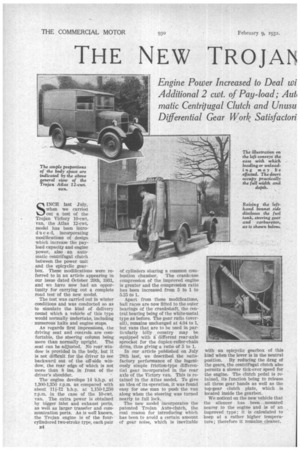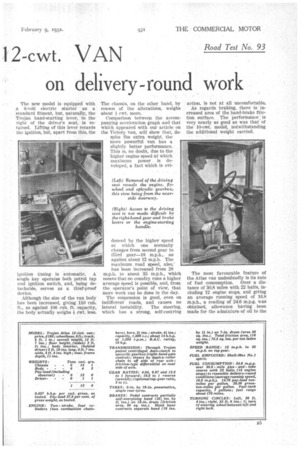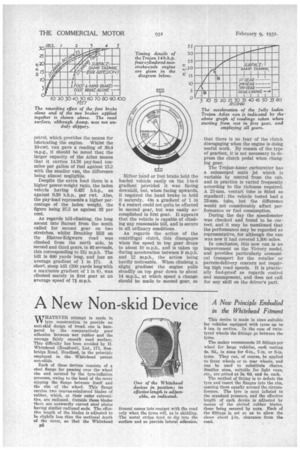THE NEW TRO JAN 2-cwt. VAN Road Test No. 93
Page 38

Page 39

Page 40

If you've noticed an error in this article please click here to report it so we can fix it.
on delivery-round work
SINCE last July, when we carried out a test of the Trojan Victory 10-cwt. van, the Atlas 12-cwt. model has been introduc e d, incorporating modifications of design which increase the payload capacity and engine power, also an automatic centrifugal clutch between the power unit and the epicyclic gearbox. These modifications were referred to in an article appearing in our issue dated October 20th, 1931, and we have now had an opportunity for carrying out a complete road test of the new model.
The test was carried out in winter conditions and was conducted so as to simulate the kind of delivery round which a vehicle of this type would normally undertake, including numerous halts and engine stops.
As regards first impressions, the driving seat and controls are comfortable, the steering column being more than normally upright. The seat can be adjusted. No rear window is provided in the body, but it is not difficult for the driver to see backward out of the off-side window, the rear edge of which is not more than 8 ins. In front of the driver's shoulder.
The engine develops 14 b.h.p. at 1,300-1,350 r.p.m. as compared with about 111-12 b.h.p. at 1,150-1,250 r.p.m. in the case of the 10-cwt. van. The extra power is obtained by bigger inlet and exhaust ports, as well as larger transfer and communication ports. As is well known, the Trojan engine is of the four, cylindered two-stroke type, each pair
of cylinders sharing a common combustion chamber. The crankcase compression of the improved engine is greater and the compression ratio has been increased from 5 to 1 to 5.25 to 1.
Apart from these modifications, ball races are now fitted to the outer bearings of the crankshaft, the central bearing being of the white-metal type as before. The gear ratio (overall), remains unchanged at 4.04 to 1, but vans that are to be used in particularly hilly country may be equipped with a different rear-axle sprocket for the duplex-roller-chain drive, thus giving a ratio of 5 to 1.
In our article published on July 28th last, we described the satisfactory performance of the ingeniously simple friction-type differential gear incorporated in the rear axle of the Victory van. This is retained in the Atlas model. To give an idea of its operation, it was found easy for one man to push the van along when the steering was turned nearly to full lock.
The new model incorporates the patented Trojan Auto-clutch, the real reason for introducing which has been to avoid a certain amount of gear noise, which is inevitable
with an epicyclic gearbox of this kind when the lever is in the neutral position. By reducing the drag of the gears, the centrifugal clutch also permits a slower tick-over speed for the engine. The clutch pedal is retained, its function being to release all three gear bands as well as the top-gear clutch plate, which is located inside the gearbox.
We noticed on the new vehicle that the silencer has . been mounted nearer to the engine and is of an improved type ; it is calculated to keep at a rather higher temperature; therefore it remains cleaner. The new model is equipped with a 6-volt electric starter as a standard fitment, but, naturally, the Trojan hand-starting lever, to the right of the driver's seat, is retained. Lifting of this lever retards the ignition, but, apart from this, the ignition timing is automatic. A. single key operates both petrol tap and ignition switch, and, being detachable, serves as a thief-proof device.
• Although the size of the van body has been increased, giving 110 cub. ft., as against 106 cub. ft. capacity, the body actually weighs cwt. less. The chassis, on the other hand, by reason of the alterations, weighs about cwt. more. • Comparison between the accompanying acceleration graph and that which appeared with our article on the Victory van, will show that, despite the extra weight, the' more powerful van has a slightly better .performance. This is, no doubt, due to the higher engine speed at which maximum power is developed, a fact which is evi
dewed by the higher speed at which one normally changes from second gear to third gear-18 m.p.h., as against about 12 m.p.h. The maximuni road speed, also,has been increased from 28 m.p.h. to about 35 m.p.h., -which means that on country runs a higher 'average speed is possible, and, from the operator's point of view, that more work can be done in the day.
The suspension is good, even on indifferent roads, and causes no lateral instability. The steering, which has a strong, self-centring action, is not, at all uncomfortable.
As regards braking, there is increased area of the hand-brake friction surface. The performance is very nearly as good as was that of the i0-cwt. mcidel, notwithstanding the additional weight carried.
The most favourable feature of the Atlas van undoubtedly is its rate of fuel consumption. Over a distance of 30.8 miles with 22 halts, including 12 engine stops, and giving an average running speed of 16.8 m.p.h., a reading of 24.6 m.p.g. was obtained, allowance having been made for the admixture of oil to the
petrol, which provides the means for lubricating the engine. Whilst the 10-cwt. van gave a reading of 30.4 m.p.g., it should be noted that the larger capacity of the Atlas means that it carries 14.76 pay-load tonmiles per gallon of fuel against 15.2 with the smaller van, the difference being almost negligible.
Despite the extra load there is a higher power-weight ratio, the laden vehicle having 0.437 b.h.p., as against 0.39 b.h.p., per cwt. Also, the pay-load represents a higher percentage of the laden weight, the figure being 37.5 as against 33 per cent.
As regards hill-climbing, the long ascent into Barnet from the south called for second gear on two stretches, whilst Brockley Hill on the Elstree-Edgware road was climbed from the north side, in second and third gears, in 93 seconds, this corresponding to 131 m.p.h. The hill is 600 yards long, and has an average gradient of 1 in 17i. A short, steep hill (200 yards longwith a maximum gradient of 1 in 6), was climbed mainly in first gear at an average speed of 7t m.p.h.
Either hand or foot brake held the loaded vehicle easily on the 1-in-6 gradient provided it was facing downhill, but, when facing upwards, it required the hand brake to hold it securely. On a gradient of 1 in 6 a restart could not quite be effected In second gear, but was easily accomplished in first gear. It appears that the vehicle is capable of climbing any reasonable hill, and is secure in all ordinary conditions.
As regards the action of the centrifugal clutch, this disengages when the speed in top gear drops to about 10 m.p.h., and is taken up during acceleration between 9 m.p.h. and 12 m.p.h., the action being hardly noticeable. When climbing a slight gradient the engine pulls steadily on top gear down to about 14 m.p.h., at which speed a change should be made to second gear, so that there is no fear of the clutch disengaging when the engine is doing useful work. By reason of the type of gearbox, it is not necessary to depress the clutch pedal when changing gear.
The Trojan-Amac carburetter has a submerged main jet which is variable by control from the cab, and in practice is varied frequently according to the richness required. A 21-mm. venturi tube is fitted as standard ; the vehicle tested had a 23-mm. tube, but the difference would not considerably affect performance or fuel consumption.
During the day the speedometer was checked and found to be correct, and it may be mentioned that the performance may be regarded as representative, for although the van was new it had covered 1,300 miles.
In conclusion, this new van is an improvement on the Victory model, and provides particularly economical transport for the retailer or parcels-delivery concern not requiring high road speeds. It is practically fool-proof as regards control and management, and does not call for any skill on the driver's part.




























































































